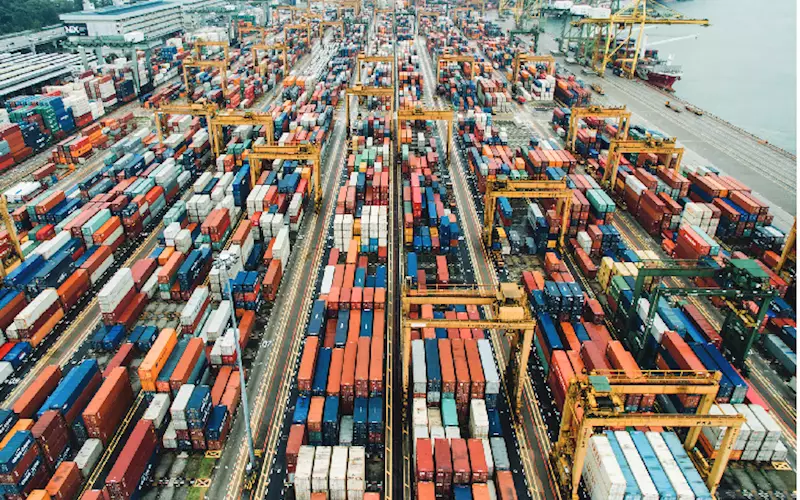No longer shall exports stand still …
The AIFMP virtual session on 19 March shed light on how print businesses could leverage the export potential. Aultrin Vijay reports
04 May 2022 | By Aultrin Vijay
In his welcome address, Chander Pasupathy, president of AIFMP highlighted the challenge due to the “Prices of solvent and crude oil and containers are rising, and we don’t know how long it will last.” Manoj Mehta, chairman of export promotion at AIFMP and director, UT Pack Industries added, “the past two years have impacted our lives in more ways than one”. He lauded the government’s initiatives to boost exports.
“Today, print and packaging exports impact the growth of any industry and contribute to the economy. The government is encouraging manufacturing and exports across sectors, including the print industry,” Mehta says. “The launch of important schemes such as Production-Linked Incentive (PLI) initiated by the government is a real blessing.”
Mehta and Chander both concurred that “The current political and economic turbulence has affected the print markets. But exports have provided some companies with an opportunity to mitigate some of the input inflation. However, exports have had to deal with additional logistical threats and political confusion.
Satish Malhotra, managing director of New Delhi-based Swan Press and chairman of paper, paperboard and paper products panel of Chemical and Allied Export Promotion Council (Capexil), in his keynote address, crunched some numbers for the benefit of the delegates. With the advent of the pandemic, the print and packaging industry was negatively affected, “but exports did not falter,” was the Malhotra message. He says, “During 2021-2022 (until February), exports rose by 74%.” He predicts that the share of paper exports would go up to 65% this year, more than other paper products.
Nilesh Dhankani, founder and CEO of Quarterfold Printabilities shared his company’s success story. “With continuous investments in print and post-press production, our main focus has been in the education sector, both in Africa and India,” he says, adding that many nations are looking at India as a trade partner due to the low sentiments vis-à-vis China. Quarterfold sought opportunities in East and West Africa, where there are no printing facilities and it is prudent for those nation-states to import books.
Export consultant Ajit Shah praised the government’s agenda to encourage exports. He said that the Ministry of Commerce has USD 400 billion as export target and the finance ministry had duty drawback schemes for those willing to enter the exports business.
“For those who want to enter the export business, the government is providing you a duty drawback scheme of 1.3% to 1.7% in duty drawback. Another scheme, RODTEP, which was introduced in January 2021, gives remission in duties and taxes from 1.1% to 2.4%,” Shah adds.
India’s export potential is huge: Satish Malhotra

Prior to the pandemic, India had a market share of 2% in the international trade of paper and paper products. It was low as compared to China’s which operated at 18%-20% of the market share. However, in the last two years, because of the shift in trade dynamics, India is capable of garnering a bigger share.
From April 2019 to March 2020, exports of paper and paper products were USD 2,000 million (approximately Rs 15,000 crores). However, with the advent of pandemic in 2021, Indian exports did not falter and the numbers remained steady.
From 2021-2022 (until January 2022), exports saw growth of 74%. This is phenomenal growth. It speaks about the potential that exists in the world.
By the end of the year there is an expectation that we would have touched Rs 25,000 crores in terms of exports of the products coming under the paper and paper products panel of Capexil (these numbers include paper and paperboard exports).
Prior to the pandemic, almost 55% of exports were done by the paper mills and the balance 45% export business was by converters of paper and paperboard. In the last one year, due to the pandemic, there have been changes and dislocations around the globe. China, which was a big exporter of paper, decided a few years ago to clamp down on polluting paper mills and has also become an importer of paper, and few Indian mills are exporting them packaging and other grades of papers.
Looking at the data, we get a clear idea that an exports-thrust is the need of the hour and if we can do it right, there is a potential of being a game-changer.
Why should we export?
The moment we eye the export market, we will increase our turnovers and our reach becomes global. If we are able to achieve the right balance between servicing the local market as well as the export market, then we will achieve maximum capacity utilisations.
Very often, export businesses offer a boost during uncertain times. Businesses have to deal with lean periods and seasonal products.
One thing I really want to share with my fellow printers is, when we opt for exports, standardisation of quality is paramount. Internationally, there is only one way to do a job and that is to do it perfectly. India has to imbibe that attitude.
The second point is the policy of sale or return in international markets. If your customer is not satisfied with the quality and rejects the order, you cannot ask for payments. That is how the international markets work. You must upgrade your quality. International customers means international standards.
Policies aiding exports
Our constitution says that we have to export goods and services and not the taxes. The government also tries to formulate policies wherein we can be cost effective in global markets. For all the inputs that we are using, there are various schemes generated whereby we can strip the taxes that have gone into those products. Eventually, when you are exporting, you incur costs, which are rid of all the taxes, so that you have a level playing field with global players in other countries, and you can become very competitive.
Today, the government provides you with export subsidies, direct payments, low cost loans, tax exemptions, subsidised marketing schemes, and participation in trade fairs. Now, the government has come up with new initiatives wherein infrastructure is being strengthened, new logistic division has been set up, Remission of Duties and Taxes on Export Products (RODTEP) scheme has been introduced to provide rebate in the taxes that have gone into our products, and there are schemes meant for service sectors, export hubs, and there are many more packages.
But ultimately a Government package will help maintain those already involved in export markets and perhaps push those actively looking towards them.
Under the Capexil umbrella, our objective is to reach out to the new and potential exporters including micro, small and medium enterprises, initiate them, advise them and even mentor them through multiple export orientation programmes and schemes. At the same time, we take feedback from the industry and if there are real issues that need to be addressed and notify the government.
Exporting can be a boon to a print business, especially if it works hard to corner a particular niche or to build a reputation as a specialist.
Growth percentage of paper products
- Envelopes, writing blocks and letter pads: 54%
- Exercise books, diaries: 25%
- Paper bags, boxes and other containers: 68.5%
- Paper cones and tubes: 29%
- Miscellaneous paper products: 38%
- Playing card exports: 72%
- Tissue paper and cigarette paper: 86%
Opportunities galore, says Nilesh Dhankani
It’s important to explore. It’s important to invest in time and travel to every country and examine the potential, do your research, and study the trends. It is difficult to conduct your business online or by email. At Quarterfold, we offer a total gamut of services. That’s one part of the process. One has to convince your client about all your strengths. You cannot sell a product in an online setup. Out of sight is out of mind.
Our major contributor has been Africa. Recently I’ve realised that the United States, Canada and Europe are looking at India as a trade partner because of the low sentiment vis-a-vis China.
China and Vietnam are contributing a much larger percentage in terms of export. The time is opportune for India when one considers the current geopolitical atmosphere.
There are some fairs where organisations such as UNESCO and agencies from the US, Europe and some Islamic Funds promote education. This means funding for printing of books to develop content and school infrastructure. Earlier, the printing projects were produced by China, Malaysia, Indonesia, South Korea and Vietnam; now India has an opportunity. Also, there are opportunities from donor agencies, which fund the local ministries of education in Africa to distribute books to every single student in their country. It’s a big volume business. The information is available on World Bank tenders and UNESCO websites. However, Indian book exporters must note that these are low margin businesses in Africa.
Point is, there are a lot of book fairs. A book exporter must participate in all the book fairs and show-off potential and capabilities. Market yourselves, be present, imbibe the culture, and be a part of their culture. You can’t be conservative on your own terms. Build the trust factor and relationship. Right now 80% of Quarterfold’s business are customers who we’ve been catering for seven years. With time we have built a good relationship – I trust them, they trust me.
Sometimes payments are delayed because of money market fluctuations and choking up of cash flow. But that’s part of the export business. A book exporter cannot panic. One should be aware of the risk factors.
The other businesses come in the form of value-added services. Apart from printing, a book print firm can add value by incorporating content such as illustrations and layouts. Of course, the profit margin goes up because you charge for content and not merely ink on paper.
Africa is a continent with many countries. Some parts of Africa, especially the East and West, don’t have high quality printing facilities. When they import paper, they pay heavy duties, which is 25%-30%. Therefore they import education books, which is a duty-free product worldwide. Hence we took the opportunity and started exploring East Africa, West Africa, and reached Central Africa and South Africa.
Quarterfold is a book printing company, but we are getting into exports of premium notebooks (back-to-school books and stationery notebooks). It’s a big market, which is dominated by Vietnam and China. One order size can be 200 containers and the business is in millions. Walmart, Tesco and many German companies are looking at India for these products. Only thing is India needs to be more innovative, creative and more stylish in terms of making the product.
Usually, people go to fairs, take some books, and copy the designs. This method will not work today. The current Indian generation is quite design-oriented and can create premium diaries, notebooks, pads, calendars and more. Usually these purchases transpire through buying agents. Big corporations in the US, UK and Europe have their buying agents across India, China and the Middle East. If you network with them, convince them, enrol with them, you can solicit a lot of enquiries. The end thing is to be honest and give the best quality product.
Another important segment is religious book publishing. If you get the right contact, religious book printing can book your whole press for a year. Education and religious books are the two segments, which are growing every year. We have executed large projects and shipped close to 150 containers from both our factories within 45 to 50 days. Our benchmark is to ship out 60-plus (40ft containers) each month for the next financial year.
Exporting is a volatile market with a peak-and-trough nature but in any given year it brings in a sizable profit for us. It is a challenging business to be in, but it can be very rewarding.
Takeaway for Indian exporters
- Give customers realistic timelines
- Update timelines with course of shipping through real time tracking
- Export with required permits
- Consider the country-specific import controls and laws
- Give your client a seamless purchase and delivery experience












 See All
See All